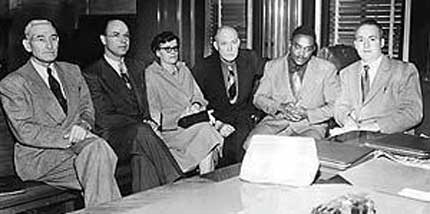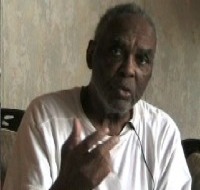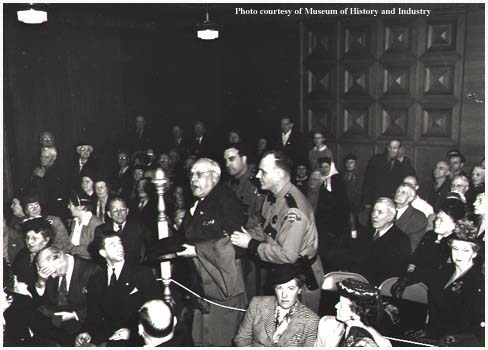
A Seattle Times photograph of six of the Seattle Seven: Henry Huff, William Pennock, Barbara Hartle, Terry Pettus, Paul Bowen, and Daschbach. Karly Larsen had separate legal representation and refused to be photographed with the other defendants.
On the morning of September 17, 1952, FBI agents stormed the houses and workplaces of seven Seattle citizens. Each arrest was made as if the seven were “dangerous criminals.” Their crime: participating in and advocating a conspiracy to violently overthrow the United States government. The Alien Registration Act of 1940, better known as the “Smith Act,” was initially designed to monitor immigrants and prosecute those suspected of collaborating with fascist enemy powers. But after World War II, as relations with the US and Soviet Union changed from reluctant allies to avowed enemies, the Justice Department turned the Smith Act into a weapon against the left, manipulating the law to target American citizens alleged to be leaders of the Communist Party.
The Alien Registration Act was introduced by Virginia Congressman Howard Smith, passed by Congress, and signed by President Roosevelt on June 28, 1940, World War II was raging in Europe and Asia and Congress, worried about espionage, passed the law to keep track of immigrant noncitizens. It required adult noncitizens to register with the federal government and be fingerprinted. A second provision established criminal penalties for subversive activities, targeting those who “knowingly or willfully advocate, abet, advise or teach the duty, necessity, desirability or propriety of overthrowing the Government of the United States or of any State by force or violence, or for anyone to organize any association which teaches, advises or encourages such an overthrow, or for anyone to become a member of or to affiliate with any such association.” Initially the threat was deemed to come mostly from fascist groups who might aid the Axis powers. During the war the Justice Department used the law to prosecute Nazi sympathizers. Trotskyists who militantly opposed the defense buildup were the other early target. In 1941, the FBI arrested and charged 29 leaders of the Socialist Workers Party, accusing them of undermining the war effort.

Attrorney John Caughlan led the Seattle Seven defense team. Click above to read about Caughlan and view his video oral history.As the Cold War with the Soviet Union escalated in the late 1940s the government turned the Smith Act into a weapon against the Communist Party, prosecuting one group of leaders after another in an effort to decapitate the American party. It began with the July 20, 1948 arrests of the “New York Eleven.” This case was significant in determining the legality of the Act. Eugene Dennis, General Secretary of CPUSA and a member of the “New York Eleven,” appealed his conviction, challenging the constitutionality of the Smith Act. But on June 4, 1951, the Supreme Court upheld the convictions, declaring that the Act did not violate the free-speech guarantees of the First Amendment. The Justice Department proceeded to bring indictments against other alleged Communists. On June 20, 1951, seventeen more New York citizens were charged, followed by six arrests in Pittsburgh, fourteen in California, and on August 7, six suspected communist leaders in Maryland were charged with federal offenses. Just before the Smith Act reached the Pacific Northwest in 1952, seven assumed communist leaders were arrested in Honolulu[1].

Paul Bowen talks about his life and the Smith Act trial in this online video oral historyOn September 17, 1952 Henry Huff, Karley Larsen, John S. Daschbach, Terry Pettis, William Pennock, Barbara Hartle, and Paul Bowen were arrested and charged with conspiring to overthrow the US government. Huff, Larsen, and Hartle were arrested in Oregon at union meetings, and ordered back to Seattle[2]. Karley Larsen had, for seventeen consecutive years, held the position of the first vice-president of the International Woodworkers Union of Western Washington. Henry Huff was the Washington state chairman of the Communist Party. Barbara Hartle, the only woman in the Seattle Seven, was known around the Pacific Northwest to thousands of workers for her rousing speeches at communist rallies. She was an outspoken proponent and member of the Communist Party. To the FBI, Hartle was “Washington’s top woman Communist.”[3] Hartle was arrested at a regional meeting of the Civic Unity Committee, a Seattle civil rights organization. Paul Bowen and Terry Pettus, both well-known members of the Communist Party, were detained outside of the Seattle area. Bowen, the only African-American in the group, was an active trade unionist, advocated for civil rights, and was a United States war veteran.[4] Pettus made his living as the Northwest editor for the People’s World, a West-Coast communist newspaper. John S. Daschbach and William (Bill) J. Pennock were both in Seattle at the times of their arrests. Dashbach was a “champion of the fight against repressive law and in behalf of the rights of the [African-American] people and director of the Civil Rights Congress,” according to the People’s World.[5] Pennock, president of the Washington Pension Union, or WPU, (an organization Bowen and Pettus also belonged to), had served eight consecutive years as a Democratic Representative in the Washington state legislature and was recognized as an upstanding member of the Seattle community. Although all were, at least at one point in time, vocal members of the Communist Party, none were ever charged with any acts of violence or conspiracy. Essentially, it was the defendants’ ideological beliefs that were being put on trial.

Harley Mores, a Snohomish County farmer, worked as a Communist Party informant for the FBI. He was one of the government's "surprise witnesses" during the trial. Communists were not the only people upset with the blatant violation of rights and “Nazi-like qualities” of the Smith Act.[6] Many citizens in the Seattle community wrote to local newspapers protesting the arrests. Members of the Civil Rights Congress, an organization linked to the CPUSA, condemned the arrests in a press release, arguing that “in the arrests the government has illegally invaded not only the Communist Party, but it has invaded labor and the press organizations of the people which are composed of persons of all political opinions”.[7] The Washington Pension Union held a rally to protest the arrests, where wives of the defendants told their stories.[8] Friends and family members spoke of the injustices and prejudicial treatment the seven defendants were receiving. While visiting their loved ones in jail, family members witnessed open discrimination: the Seattle Seven were allowed visitation only by relatives on Saturdays, a rule not followed in regards to any other inmates.[9] When lawyers or family members did visit on Saturdays, they were forced to write down their names and addresses. Each defendant was set a bail of $25,000 , which was prohibitively high. For Huff, the amount was even higher, at $40,000.[10]
The bail hearing of Pennock and Daschbach, which took place on September 19, 1952 at the Federal Courthouse in Seattle, was packed. Over 50 WPU members, along with the families of the defendants and numerous reporters, were present as bail was reduced from $25,000 to $10,000.[11] Daschbach and Pennock were the only two in Seattle at the time of their arrests, which is why their bails were challenged separately. In the beginning, all of the defendants hired their own lawyers, but as they began preparing for the trial in early 1953, the separate attorneys organized together as a defense team. Pettus, Hartle, Bowen, Daschbach, and Pennock were represented by Irvin Goodman, C.T. Hatten, Sarah Lesser, Siegfried Hesse, and John Caughlin, who soon became the group’s lead attorney. John Walthew represented Karly Larsen. who declined to work with the other defendants while insisting that he had left the Communist Party in 1946.[12]

State police excort Terry Pettus from the chamber after Pettus loudly protested the 1948 Canwell Committee hearings.Courtesy Museum of History and Industry.On November 7, 1952, Caughlin filed a motion to dismiss the charges. He claimed the trial would violate his clients’ sixth amendment right to an “impartial jury of their peers” due to the hysteria and notoriety surrounding the trial. Next, Caughlin asserted that the Smith Act itself was unconstitutional and therefore the defendants should be freed of all charges. Lastly, he claimed that the vagueness and insufficiency of the charges brought against all seven of the defendants was enough to throw the case out. The motion was quickly denied, Daschbach then wrote a personal request for dismissal due to the unconstitutional nature of the Alien Registration Act, the prejudices surrounding their imprisonment and arrests, and the violation of his sixth amendment rights. He wrote that his arrest was made to be “as melodramatic and startling as possible,” and that the publicity that followed would work against any possibility of acquiring a fair and unbiased jury.[13]The court ignored this and also denied the defendants motion for postponement, which the defense said it needed in order to adequately prepare their case.
Judge William Lindberg presided as the trial began in April of 1953, at the Federal District Courthouse on 5th Avenue and Madison in downtown Seattle.[14] Court was in session Tuesday through Friday, starting promptly at 9:30am and ending at 4pm. In his opening statement, John Caughlin claimed the defendants’ “efforts have been devoted to protecting democratic liberties guaranteed by the constitution.”[15] The defense team did not seek to support or defend the Communist Party and the defendants’ ideologies, as had been the strategy of the previous Smith Act trials. Instead, Caughlin and his team argued that the United States Constitution protected basic civil liberties, allowing their clients the right to personal beliefs. Later, members of the original Seattle Seven succinctly explained their defense in a letter to the St. Louis Smith Act defendants in 1954, exclaiming that “the Smith Act is a thought control act, completely repugnant to the American tradition of free speech, press, and association.”[16]
 Barbara Hartle (left), a leading member of the Communist Party in Washington State and one of the Seattle Seven, agreed to cooperated with the FBI after her conviction in the Smith Act trial. Here she testifies before the House UnAmerican Activities Committee in 1954..Tracy Griffin represented the United States government as the lead prosecutor. The prosecution argument against the defendants was twofold. First, all seven defendants were charged with entering into a conspiracy to advocate the overthrow of the United States government (illegal under the Smith Act). Second, they were accused of forming the Communist Party in the Northwest as a vehicle to carry out this conspiracy. Griffin’s tactic was to connect the “Communist Party literature [to] the intentions and motivations” of the seven on trial.[17] To do this, he read aggressive passages of Marx, Lenin, and Stalin from Communist Party literature throughout the trial.
Barbara Hartle (left), a leading member of the Communist Party in Washington State and one of the Seattle Seven, agreed to cooperated with the FBI after her conviction in the Smith Act trial. Here she testifies before the House UnAmerican Activities Committee in 1954..Tracy Griffin represented the United States government as the lead prosecutor. The prosecution argument against the defendants was twofold. First, all seven defendants were charged with entering into a conspiracy to advocate the overthrow of the United States government (illegal under the Smith Act). Second, they were accused of forming the Communist Party in the Northwest as a vehicle to carry out this conspiracy. Griffin’s tactic was to connect the “Communist Party literature [to] the intentions and motivations” of the seven on trial.[17] To do this, he read aggressive passages of Marx, Lenin, and Stalin from Communist Party literature throughout the trial.
The six-month-long trial was marked by a number of surprises and a shocking death. On May 19th, about a month into the trial, the prosecution announced that the next day they would put an undercover surprise witness on the stand. When Caughlin requested that Judge Lindberg make the prosecution reveal the name of the witness and allow the defense adequate time to prepare a cross-examination, he was denied.[18] In an article written a day later, a writer for the Seattle Post-Intelligencer admitted the undeniable biases hurting the defendants, the denial of Caughlin’s request being an obvious example. The next day the surprise witness appeared. Harley More, a member of the International Woodworkers of America–CIO union in Snohomish, admitted to being paid $10,000 by the FBI for his work as an informant. He admitted that he had worked to recruit people into the Communist Party, turning those names over to the FBI.[19] Harley claimed that he had personally witnessed “communist behavior” by Karly Larsen at many union meetings they both attended.[20]

William Pennock was president of the Washington Pension Union and had been elected t6o several terms in the state legislature. He took his own life before the trial concluded. The most dramatic event to take place during the trial occurred on August 2, 1953, when William J. Pennock committed suicide. The President of the Washington Pension Union and former member of the state legislature was found dead on the 80th trial day in his West Seattle home. He had ingested a lethal dose of prescription drugs.[21]
After months of testimony from forty witnesses the case went to the jury in October 1953. Larsen, who had consistently denied party membership, was acquitted. The others were found guilty of violating clauses of the Smith Act. Although not a single piece of evidence was brought forth indicating that any of the defendants had committed violent acts of rebellion, the jury convicted on the charge of “advocating a conspiracy to overthrow the United States government.” The defendants were sentenced to the maximum penalty: five years in prison and fined $10,000 each.[22]
Then a huge surprise. Barbara Hartle, who had been a stalwart party member since 1933 and had been one of the highest ranking leaders in the 12th District covering the Pacific Northwest, agreed to work with the FBI. Her conviction was vacated and she spent the next several years testifying against her former colleagues. She was the star witness when the House UnAmerican Activities Committee held hearings in Seattle in 1954.[22]
John Dashbach, Terry Pettus, Paul Bowen, and Henry Huff each managed to make bail after a couple of months and were released pending an appeal to the United States 9th Circuit of Appeals. At that time, the United States Supreme Court was deciding whether or not to review the California Smith Act trials. The 9th Circuit Appeals Court chose to wait for the decision in the California case before hearing the Seattle appeal. The defendants waited more than four years. When the Supreme Court ruled against the Smith Act in 1957, the convictions were vacated and Dashbach, Pettus, Bowen, and Huff were at last free.[22]
Nationally, over 140 United States citizens had been arrested by 1957 for violations of the Smith Act. The Supreme Court made two important decisions that effectually voided the Smith Act in 1957 and 1958. In Yates v. The United States, the justices decided that the teaching of abstract ideas was not the same as advocating a conspiracy. Soon after, in Watkins v. The United States, it was maintained that it was not the business of the federal government to expose their citizens’ private affairs. Although the Smith Act is still on the books today, it has not been used since 1961.
HSTAA 353
Spring 2008
[1] “Smith Act News.” Civil Rights Congress of New York, Vol. 1 No. 1, 20 September 1951, John S. Daschbach Collection, University of Washington. Folder 5/20.
[2] Seattle Times. 19 September 1952. John S. Daschbach Collection, University of Washington. Folder 5/18.
[3] Ibid.
[4] Daily People’s World October 1952. John S. Daschbach Collection, University of Washington. Folder 5/18.
[5] Ibid.
[6] Civil Rights Congress News Release. 18 September 1952. John S. Daschbach Collection, University of Washington. Folder 5/12.
[7] Ibid.
[8] Nelson, Eleanor. Letter to Aubrey. 22 September 1952. John S. Daschbach Collection, University of Washington. Folder 5/4.
[9] Ibid.
[10] Seattle Times. 19 September 1952. John S. Daschbach Collection, University of Washington. Folder 5/18.
[11] Ibid.
[12] Caughlin, John. Letter to defense team. 1952. John S. Daschbach Collection, University of Washington. Folder 5/4.
[13] Daschbach, John. Letter to Federal District Court. 1952. John S. Daschbach Collection, University of Washington. Folder 5/14.
[14] “Newsletter” No. 6. Northwest Citizen’s Defense Committee 21 May 1953. John S. Daschbach Collection, University of Washington. Folder 5/13.
[15] Miller, Margaret Ada. “The Left’s Turn: Labor, Welfare Politics, and Social Movements in Washington State, 1937-1973.” (PhD Diss. U of Washington, 2000) p.203
[16] Seattle Defendants. Letter to St. Louis defendants. 16 January 1954. John S. Daschbach Collection, University of Washington. Folder 5/4.
[17] Miller, “The Left’s Turn”, p204.
[18] “Newsletter” No. 6. Northwest Citizen’s Defense Committee 21 May 1953. John S. Daschbach Collection, University of Washington. Folder 5/13.
[19] “Newsletter” No. 9. Northwest Citizen’s Defense Committee 26 May 1953. John S. Daschbach Collection, University of Washington. Folder 5/13.
[20] “Newsletter” No. 6. Northwest Citizen’s Defense Committee 21 May 1953. John S. Daschbach Collection, University of Washington. Folder 5/13.
[21] Miller, “The Left’s Turn”, p204.
[22] Spokane Daily Chronicle, October 12, 1953, p36.
[23] Ellensburg Daily Record, March 30, 1954, p2.
[24] “The Cold War and Red Scare in Washington State.” Curriculum Material for WA State Schools. Center for the Study of the Pacific Northwest, University of Washington.